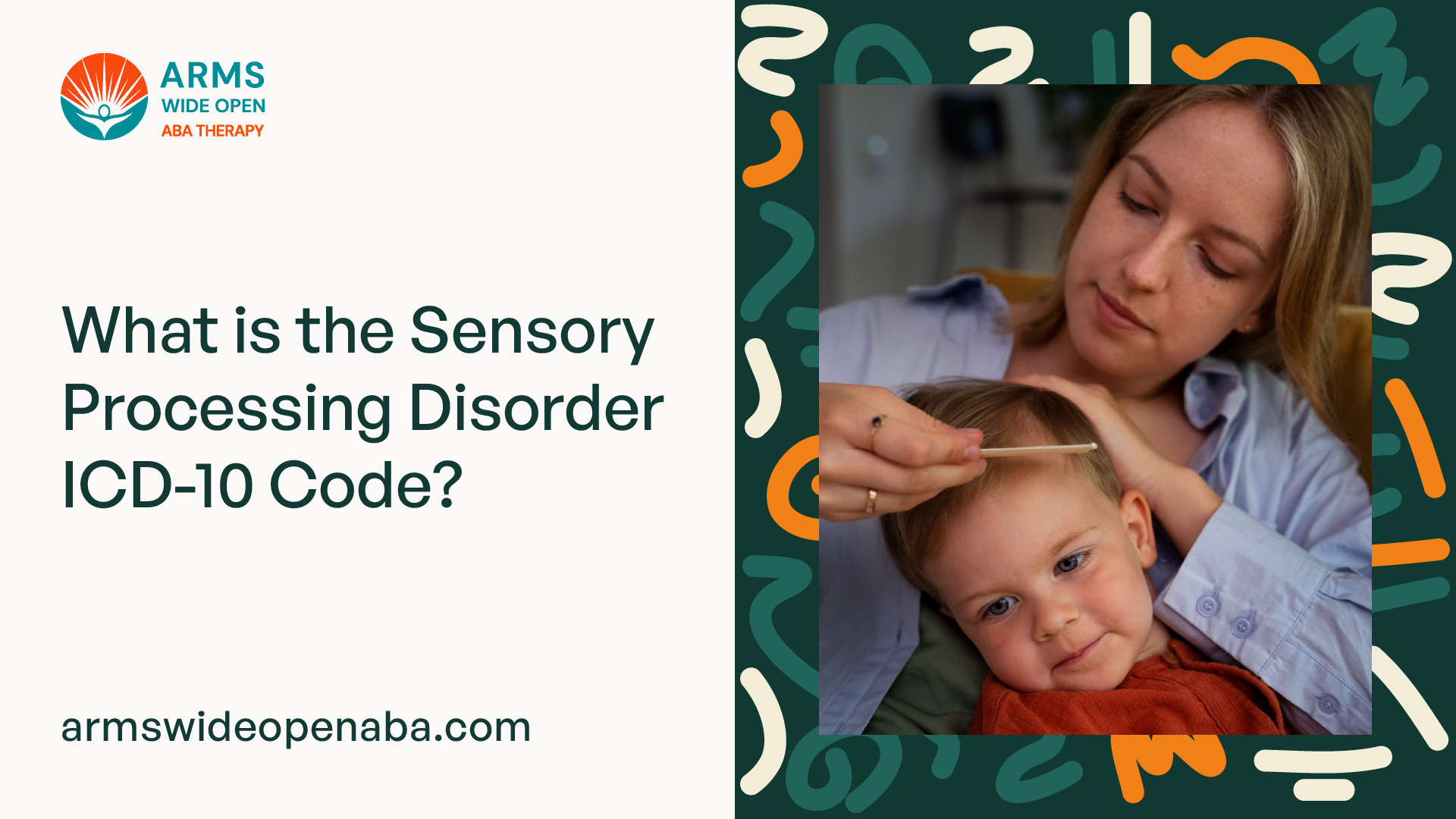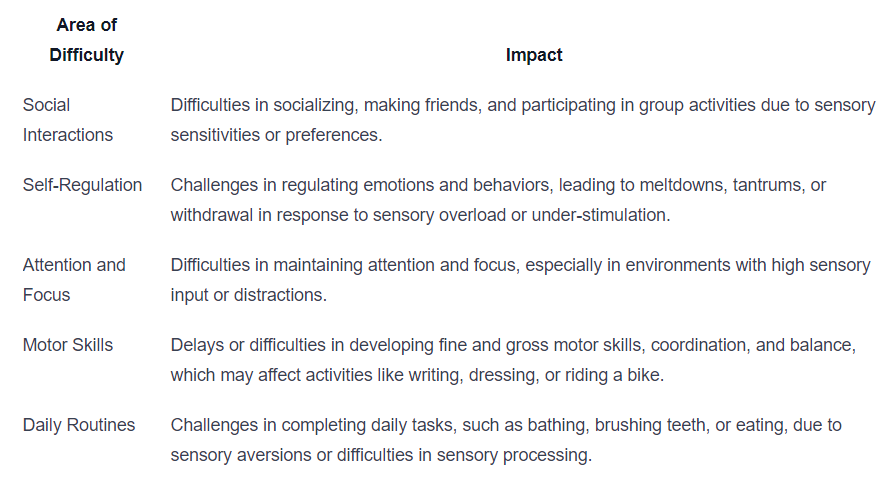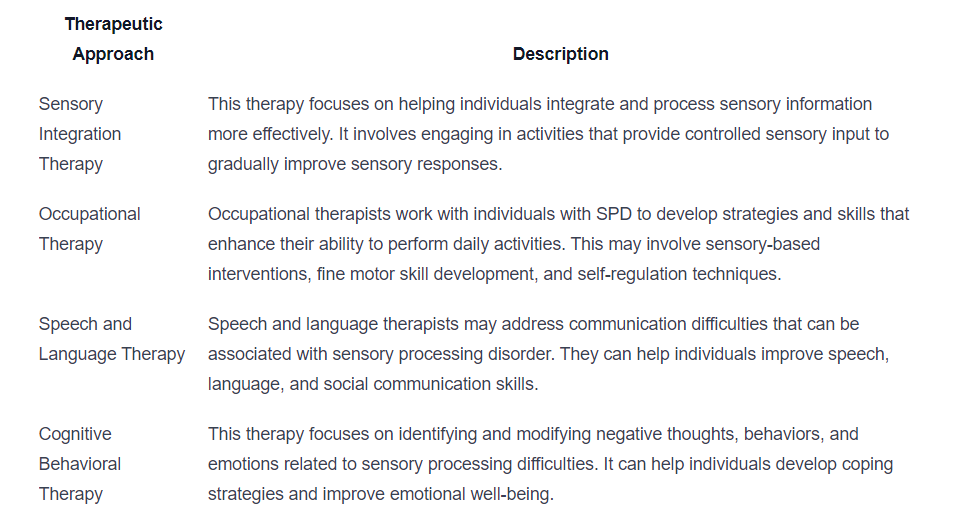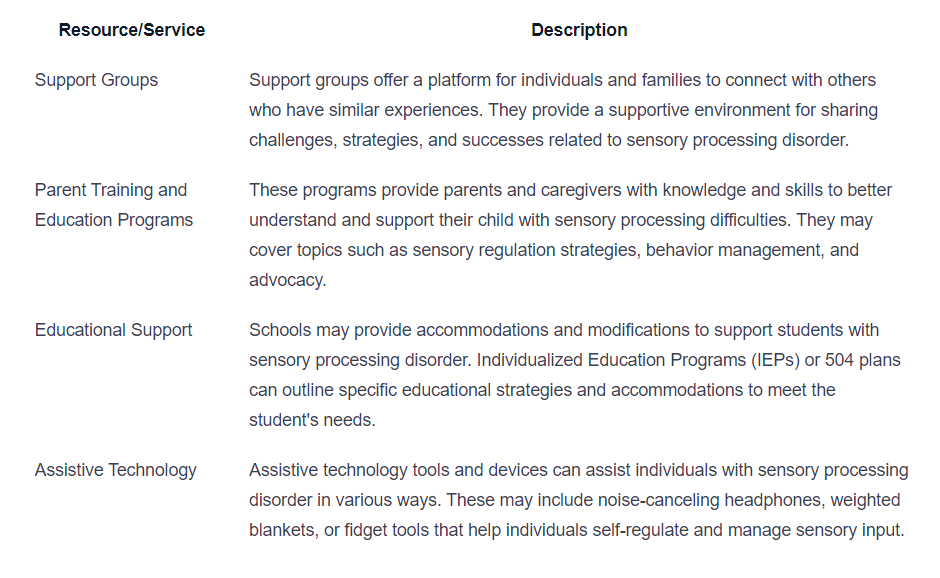What is the Sensory Processing Disorder ICD-10 Code?
Unveiling the sensory processing disorder ICD-10 code: Discover how it aids diagnosis and treatment for individuals with SPD.

Understanding Sensory Processing Disorder (SPD)
Sensory Processing Disorder (SPD) is a condition that affects how the brain receives and responds to sensory information from the environment. It is characterized by difficulties in processing and organizing sensory input, leading to challenges in daily life.

What is Sensory Processing Disorder?
Sensory Processing Disorder, also known as Sensory Integration Dysfunction, is a neurological condition that affects people of all ages. Individuals with SPD may be oversensitive or undersensitive to sensory stimuli, such as touch, sound, taste, smell, and movement. These heightened or diminished responses can impact their ability to participate in everyday activities and may result in behavioral and emotional difficulties.
SPD can manifest in various ways, depending on the individual. Some individuals may be hypersensitive to certain sensory experiences, leading to sensory avoidance and discomfort in response to stimuli. Others may be hyposensitive, seeking intense sensory input to regulate their sensory system. Additionally, individuals with SPD may have difficulties with sensory discrimination, making it challenging to differentiate between similar sensory stimuli.
Impact of SPD on Individuals
Sensory Processing Disorder can have a significant impact on individuals' daily lives and overall well-being. The challenges experienced by individuals with SPD can vary widely, as each person's sensory profile is unique. Here are some common areas where individuals with SPD may face difficulties:

Understanding the impact of SPD on individuals is crucial in providing appropriate support and interventions to help them navigate their sensory challenges and improve their quality of life. By raising awareness and promoting understanding of SPD, we can create a more inclusive and supportive environment for individuals with sensory processing difficulties.
Importance of ICD-10 Code for Sensory Processing Disorder
Having a specific ICD-10 code for Sensory Processing Disorder (SPD) plays a vital role in accurately diagnosing and documenting this condition. The ICD-10 code is a standardized alphanumeric code system used by healthcare professionals worldwide to classify and code various medical conditions.
What is the ICD-10 Code?
The International Classification of Diseases, Tenth Revision (ICD-10), is a globally recognized system developed by the World Health Organization (WHO). It provides a standardized method for classifying diseases, disorders, and other health-related conditions. The ICD-10 code for Sensory Processing Disorder is F84.9.
Significance of Having a Specific Code for SPD
The existence of a specific ICD-10 code for Sensory Processing Disorder holds several important implications:
- Accurate Diagnosis: The ICD-10 code allows healthcare professionals to accurately diagnose and classify individuals with Sensory Processing Disorder. By using a specific code, healthcare providers can ensure consistent identification and understanding of this condition.
- Research and Data Collection: Having a dedicated code for SPD enables researchers and public health agencies to collect reliable data on the prevalence, incidence, and impact of this disorder. This data is invaluable for understanding the scope of the condition, identifying trends, and developing effective intervention strategies.
- Insurance Coverage and Reimbursement: The ICD-10 code facilitates the process of insurance coverage and reimbursement for individuals with Sensory Processing Disorder. Insurance companies typically require specific diagnostic codes to validate and process claims related to medical services and treatments.
- Access to Services and Support: With a specific code, individuals with Sensory Processing Disorder can access specialized services, support, and accommodations. The code helps healthcare professionals and educators identify and address the unique needs of individuals with SPD, ensuring appropriate interventions and accommodations are provided.
- Advocacy and Awareness: The ICD-10 code raises awareness about Sensory Processing Disorder among healthcare professionals, educators, policymakers, and the general public. It validates the existence of this condition and promotes understanding, leading to increased advocacy efforts and improved support for individuals with SPD.
By incorporating a specific ICD-10 code for Sensory Processing Disorder, healthcare systems are better equipped to address the unique challenges faced by individuals with SPD. It serves as a foundation for accurate diagnosis, research, insurance coverage, access to services, and advocacy efforts, ultimately improving the lives of those affected by this condition.
Unveiling the Sensory Processing Disorder ICD-10 Code
To facilitate the diagnosis and treatment of Sensory Processing Disorder (SPD), healthcare professionals rely on a standardized coding system known as the International Classification of Diseases, Tenth Revision (ICD-10). This coding system provides a specific code for SPD, enabling accurate identification and documentation of the condition.
Overview of the SPD ICD-10 Code
The ICD-10 code for Sensory Processing Disorder is F84.0. This code falls under the category of "Pervasive Developmental Disorders" and is specifically assigned to SPD. The code F84.0 represents the unique diagnostic criteria and characteristics of individuals with sensory processing challenges.
By assigning a distinct code to SPD, healthcare providers can easily identify and track cases of the disorder. This coding system ensures consistency in diagnosis and facilitates the collection of data for research, treatment planning, and epidemiological purposes.
How the Code Helps in Diagnosis and Treatment
The SPD ICD-10 code plays a crucial role in the diagnosis and treatment of individuals with sensory processing challenges. It allows healthcare professionals to accurately document the presence of SPD in medical records, ensuring clear communication among healthcare providers and facilitating appropriate treatment plans.
Moreover, the ICD-10 code for SPD assists in insurance reimbursement processes. With a specific code assigned to SPD, healthcare providers can support claims for services related to the diagnosis and treatment of the disorder. This helps individuals with SPD access the necessary interventions, therapies, and support they require.
The availability of the SPD ICD-10 code also contributes to the advancement of research and understanding of the disorder. By accurately identifying and tracking cases of SPD, researchers can analyze data and gain insights into the prevalence, demographics, and effective treatment approaches for individuals with sensory processing challenges.
In summary, the Sensory Processing Disorder ICD-10 code (F84.0) provides a standardized way to identify, diagnose, and treat individuals with SPD. This code ensures accurate documentation, facilitates communication among healthcare providers, supports insurance reimbursement, and contributes to research efforts in the field of sensory processing challenges.
Diagnosis and Documentation
When it comes to Sensory Processing Disorder (SPD), an accurate diagnosis is crucial for individuals to receive the appropriate support and treatment. In this section, we will explore how SPD is diagnosed and the role of the ICD-10 code in documenting this disorder in medical records.
How SPD is Diagnosed
Diagnosing SPD involves a comprehensive evaluation conducted by qualified healthcare professionals, such as occupational therapists, psychologists, or developmental pediatricians. The diagnosis typically involves several steps:
- Clinical Interviews and Questionnaires: The healthcare professional will interview the individual and their caregivers to gather information about their sensory experiences and challenges.
- Observation and Assessment: The professional will observe the individual's behaviors and responses to various sensory stimuli, both in controlled environments and real-life situations. They may use standardized assessment tools to gather more objective data.
- Collaboration with Multidisciplinary Team: In some cases, a multidisciplinary team may be involved in the assessment process. This can include professionals from different fields, such as occupational therapy, speech therapy, and psychology, to gain a holistic understanding of the individual's sensory difficulties.
- Diagnostic Criteria: The healthcare professional will refer to established diagnostic criteria, such as those outlined in the Diagnostic and Statistical Manual of Mental Disorders (DSM-5), to determine if the individual meets the criteria for SPD.
It's important to note that there is currently no specific medical test or imaging study that can definitively diagnose SPD. The diagnosis is based on a comprehensive evaluation that considers various factors related to sensory processing difficulties.
Role of the ICD-10 Code in Medical Records
The International Classification of Diseases, 10th Revision (ICD-10) includes a specific code for Sensory Processing Disorder (SPD). The ICD-10 code for SPD falls under the broader category of "Other Neurodevelopmental Disorders" and is classified as F88. This code allows healthcare professionals to accurately document SPD in medical records, ensuring proper identification and communication of the disorder.
The ICD-10 code for SPD plays a crucial role in several aspects:
- Data Collection and Research: The code helps in collecting epidemiological data and conducting research on the prevalence and impact of SPD. This data can be used to further understand the disorder, develop effective interventions, and advocate for individuals with SPD.
- Insurance Reimbursement: The ICD-10 code enables healthcare providers to submit claims for reimbursement from insurance companies. This is important for individuals with SPD to access necessary therapies and interventions.
- Standardization and Communication: The code provides a standardized language for healthcare professionals to communicate and share information about SPD across different medical settings. This facilitates collaboration and ensures consistent documentation of the disorder.
By incorporating the ICD-10 code for SPD in medical records, healthcare professionals can accurately document the diagnosis, leading to better understanding, support, and access to appropriate services for individuals with Sensory Processing Disorder.
Treatment and Support for Sensory Processing Disorder
When it comes to sensory processing disorder (SPD), there are various therapeutic approaches and resources available to support individuals with this condition.
Therapeutic Approaches for SPD
Therapeutic interventions play a crucial role in helping individuals with sensory processing disorder. These approaches aim to address the challenges and difficulties associated with sensory processing issues, promoting improved functioning and quality of life. Some common therapeutic approaches for SPD include:

It's important to note that the specific therapeutic approach used may vary depending on the individual's needs and preferences. A multidisciplinary approach involving collaboration between different professionals may be beneficial in addressing the various aspects of sensory processing disorder.
Resources and Services Available for Individuals with SPD
In addition to therapeutic approaches, there are various resources and services available to support individuals with sensory processing disorder. These resources can provide valuable information, guidance, and assistance to individuals and their families. Some key resources and services include:

By utilizing these resources and services, individuals with sensory processing disorder can access the support and tools needed to navigate daily challenges and promote their overall well-being.
Understanding the available therapeutic approaches and resources is crucial in providing effective treatment and support for individuals with sensory processing disorder. By tailoring interventions to meet individual needs and accessing the appropriate resources, individuals with SPD can thrive and lead fulfilling lives.
Advocacy and Awareness
Raising awareness and promoting understanding of Sensory Processing Disorder (SPD) is crucial in supporting individuals with this condition. By increasing knowledge and empathy, we can create a more inclusive and supportive environment for those with SPD.
Promoting Understanding of SPD
Promoting understanding of SPD involves educating the general public, healthcare professionals, educators, and policymakers about the nature of this disorder. By spreading accurate information, we can dispel misconceptions and stereotypes surrounding SPD.

It's important to emphasize that SPD is a valid and recognized disorder, and individuals with SPD deserve understanding, acceptance, and support.
Importance of Advocacy Efforts in Supporting Individuals with SPD
Advocacy plays a crucial role in ensuring that individuals with SPD have access to the resources, services, and accommodations they need. Here are some key reasons why advocacy efforts are essential:
- Raising Awareness: Advocacy efforts bring attention to the challenges faced by individuals with SPD, helping to increase awareness and understanding among the general public.
- Access to Services: Advocacy can help ensure that individuals with SPD have access to appropriate diagnostic and therapeutic services. This includes advocating for insurance coverage, educational accommodations, and specialized therapy options.
- Legislation and Policies: Advocacy efforts can drive the development of legislation and policies that protect the rights of individuals with SPD. This includes advocating for inclusive educational environments, workplace accommodations, and community support services.
- Reducing Stigma: Advocacy helps combat the stigma surrounding SPD by promoting acceptance and understanding. By challenging misconceptions and stereotypes, we can create a more inclusive society that supports individuals with SPD.
- Support Networks: Advocacy efforts can help establish support networks for individuals with SPD and their families. This includes connecting individuals with local support groups, online communities, and resources that provide guidance and encouragement.
By advocating for individuals with SPD, we can create a more inclusive society that recognizes and supports the unique needs of those with sensory processing challenges. Together, we can build a world where individuals with SPD can thrive and reach their full potential.
Sources
https://www.autismparentingmagazine.com/sensory-processing-disorder-icd-10/
https://www.icd10data.com/ICD10CM/Codes/R00-R99/R40-R46/R44-/R44.8
https://www.icd10data.com/search?s=sensory+processing+disorder
Similar articles
We’re here to help you

Our team is here to assist you in this process. Contact us for any assistance.
it’s easy to apply
We Accept Most Insurances
Our in-network insurance partnerships make ABA therapy more accessible to families throughout our service areas.







Our Insurance Process
We'll request your insurance details to help us verify your plan's coverage for ABA therapy. Once we've received this information, we'll walk you through your benefits, including copayments, deductibles and out-of-pocket maximums, so you know what to expect in advance.
Our team will then handle the preauthorization and all the necessary paperwork.
.svg)





















.jpeg)


































.jpeg)




.jpeg)







.jpeg)











.jpeg)
















